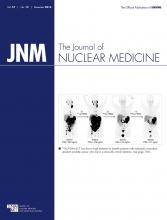TO THE EDITOR: The PET community still uses body weight to calculate SUV despite compelling evidence suggesting that lean body mass should be used instead (thereby deriving the so-called SUL [SUV based on lean body mass] as opposed to SUW [SUV based on body weight]) (1,2). SUW is overestimated in obese individuals because 18F-FDG accumulates minimally in adipose tissue. Both visceral adipose tissue and subcutaneous adipose tissue have SUVs of less than unity (visceral, ∼0.8; subcutaneous, ∼0.3) (3). The whole-body SUW is, by definition, unity (4). Not only is a strong correlation between SUW and body weight already well established, but it also has been recently shown, using a different theoretic approach (avoiding the spurious presence of weight in both coordinates), that SUL is preferable to SUW (4). Moreover, almost all publications using SUW have failed to check that the variables they have correlated against SUW do not also correlate with weight. (We ourselves were previously guilty of this oversight with respect to the liver! (5).)
Body surface area has also been suggested as a whole-body metric by which to calculate SUV (1), but this suggestion has justifiably failed to attract much interest considering that body surface area is a 2-dimensional variable rather than a 3-dimensional variable such as distribution volume. So why is it that nuclear nephrologists persist in using body surface area to scale glomerular filtration rate when, again, a 3-dimensional variable would make more sense? Body weight was abandoned for scaling glomerular filtration rate many decades ago because filtration markers such as 99mTc-diethylenetriamine pentaacetic acid and 125I-iothalamate do not enter adipose tissue, but attempts to replace body weight with 3-dimensional variables such as lean body mass (6), extracellular fluid volume (7), and total body water (8) have been largely ignored, despite widespread criticism of the use of body surface area (9).
So, in summary, both the PET community and the nephrologist community seem reluctant to give up their respective preferred whole-body scaling metrics in favor of lean body mass, which, the evidence suggests, would suit them both. Instead, nephrologists continue to use body surface area, which is the least preferred by the PET community, whereas the PET community continues to use body weight, which is the least preferred by the nephrology community! One difficulty to resolve, if we were to aim for unity, is the best formula to use for estimating lean body mass (2,10).
Footnotes
Published online ▪▪▪▪▪▪▪▪▪▪▪▪.
- © 2016 by the Society of Nuclear Medicine and Molecular Imaging, Inc.







